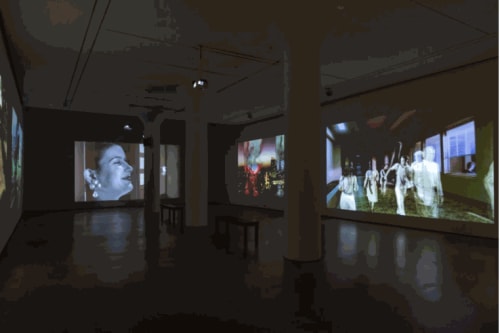Los Angeles filmmaker Pat O'Neill had only ever been inside the Ambassador Hotel once in his life before he began work on a project about the building that would absorb him for years. It was the 1950s. He was a boy. And his great-grandfather was visiting from Kansas.
"He was a grand sort of person," O'Neill says of his great-grandfather. "He stayed there, and we went to visit him and have dinner with him." At that point, the Ambassador, which had opened its doors in 1921, was more than three decades old. "It already was quite worn," he recalls.
He hardly could have imagined then what would become of the building - or that he would spend years in the 1990s working on a film that would take place within its walls.
Designed by architect Myron Hunt in a Mediterranean style, the Ambassador Hotel, for decades, was the epitome of glamour in Los Angeles - the stamping ground of Rudolph Valentino, F. Scott Fitzgerald, Elizabeth Taylor, Frank Sinatra, Joan Crawford and, on at least one occasion, Albert Einstein. It served, for a time, as a home to the Academy Awards, and its famed Cocoanut Grove nightclub boasted Casbah-inspired interiors studded with fake palm trees (leftover set pieces from Valentino's 1921 silent film "The Sheik" - or so the legend goes).
By the '60s, the hotel's glamour (and the neighborhood's) had faded, and its eventual demise was precipitated by the assassination of Robert F. Kennedy in its pantry in 1968. After that, the Ambassador became associated in name with Kennedy's death. "People just didn't want to come into the place except to gawk at the pantry, the hotel's former publicist Margaret Burk told Los Angeles magazine in 1998.
In 1989, the Ambassador shut down. Following a protracted battle over the site that involved the L.A. Unified School District and Donald Trump, much of the hotel was demolished in 2005. The site is now occupied by the Robert F. Kennedy Community Schools, an educational complex, with parts of the old hotel - a diner turned into a teachers' break room, the Cocoanut Grove rebuilt as an auditorium - integrated into the new design.
Remarkably, O'Neill, an artist and experimental filmmaker who grew up in Los Angeles and taught for spells at UCLA and CalArts, managed to gain access to the Ambassador when it was in its somnolent state in the 1990s and early 2000s. At the time, the hotel was empty, in a process of continuous decay and employed as the occasional film set ("Pretty Woman" was shot there) and a training site for the LAPD's SWAT team.
Through a friend, O'Neill secured permission to shoot the hotel, and he proceeded to create a startling and surreal visual record of the Ambassador's dilapidated guest rooms, its grand banquet halls, the empty swimming pool and the labyrinthine passageways through which Kennedy was led to his unexpected death.
To give the footage an uncanny feel, O'Neill (who for years had a day job working in special effects) built a special rig that could shoot in time lapse - one frame every 10 seconds - so that on playback, the action would move with greater speed. He captured the building's architecture, but he also recorded plays on light and time. Over these images, he layered ghostly images of actors inhabiting the hotel, as well as performers engaged in frantic dance sequences.
"The Decay of Fiction," as his film is called, debuted in 2002. To watch it is to see a building dream.
In 2018, O'Neill reconceived the film as an immersive, five-channel art installation that went on view at Philip Martin Gallery in Culver City. It is one of those shows I regret not covering at the time. Thankfully, I get a do-over because the installation version of "The Decay of Fiction" is now on view at Mitchell-Innes & Nash in New York.
The installation takes a film about architecture and turns it into an architectural work.
For O'Neill, who in 1989 created a meditative film, "Water and Power," about the ways in which water makes feasible the very idea of Los Angeles, the works focused on the Ambassador were an opportunity to immerse himself in a singular Los Angeles building. "I liked the presence of it," he says of the hotel. "I like dealing with buildings and neighborhoods that have interesting histories."
In a quiet and surreal way, he captures those histories and preserves them so that the Ambassador, though long gone, manages to remain with us in spirit.
